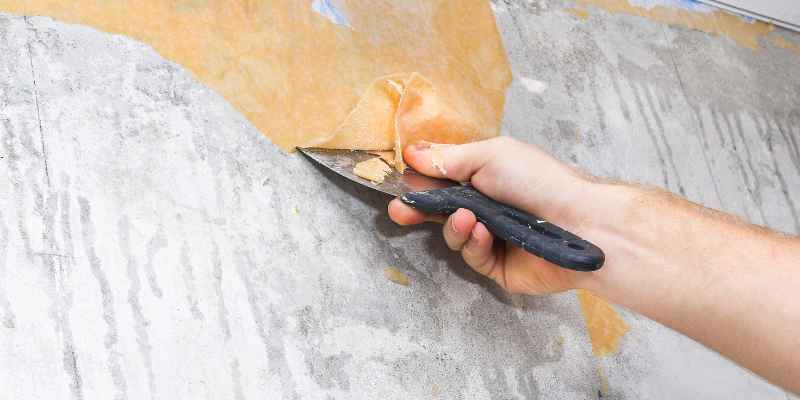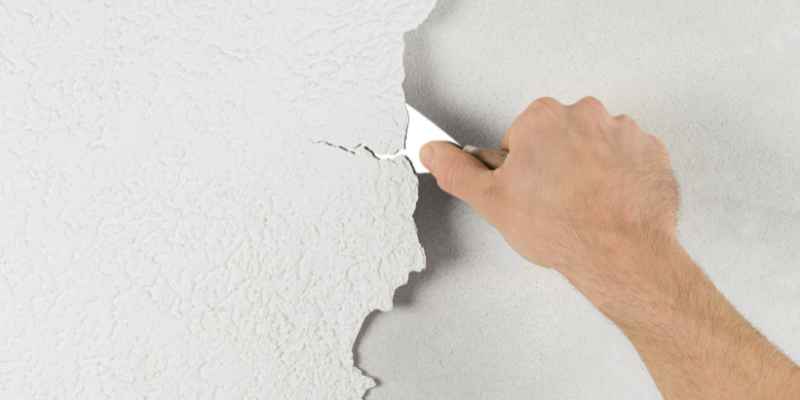To remove paint from wood without sanding, use a chemical paint stripper and a scraper. By following these steps, you can effectively remove paint from wood surfaces.
Painting wood surfaces is a common way to refresh or update the look of furniture, cabinets, or trim. However, removing paint from wood can be a daunting task, especially if you don’t want to sand the surface. Luckily, there are alternative methods to strip paint without the need for sandpaper.
This article will guide you on how to remove paint from wood without sanding by using a chemical paint stripper and a scraper. By following these steps, you can efficiently remove paint from wood surfaces and restore them to their natural beauty. So let’s dive in and learn the process of paint removal without sanding.
Method 1: Using Heat Gun
Removing paint from wood without sanding can be a time-consuming and messy task. Fortunately, there are alternative methods that are effective and can save you valuable time. One such method involves using a heat gun to gently heat the paint, making it easier to scrape off. This is a popular approach as it reduces the risk of damaging the wood surface.
Choosing The Right Heat Gun
When it comes to selecting a heat gun for this task, there are a few factors to consider. Firstly, you’ll want to make sure you choose a heat gun with a temperature range suitable for removing paint. Look for a model that offers a low heat setting to prevent scorching or burning the wood. Additionally, opt for a heat gun with adjustable airflow for better control.
Here are some key features to consider when choosing a heat gun:
| Feature | Description |
|---|---|
| Temperature control | Ability to adjust the heat output |
| Nozzle attachments | Variety of nozzle sizes for different tasks |
| Power output | Higher wattage for faster heat-up times |
| Size and weight | Consider the comfort and ease of handling |
Preparing The Surface
Before applying heat to the paint, it’s essential to prepare the wood surface. Start by cleaning the area with a mild detergent and warm water. Use a soft-bristle brush or sponge to gently remove any dirt, dust, or debris. Once the surface is clean and dry, cover any nearby furniture or flooring with a drop cloth to protect them.
Step 1: Clean the surface with a mild detergent and warm water
Step 2: Use a soft-bristle brush or sponge to remove dirt, dust, or debris
Step 3: Ensure the surface is completely dry before proceeding
Step 4: Protect surrounding furniture and flooring with a drop cloth
Applying Heat To The Paint
Now that the surface is prepared, it’s time to start using the heat gun to remove the paint from the wood. Hold the heat gun a few inches away from the painted surface and gradually move it back and forth. Keep the heat concentrated on a small area at a time, allowing the paint to become soft and bubble slightly without burning.
Step 1: Hold the heat gun a few inches away from the paint
Step 2: Gradually move the heat gun back and forth
Step 3: Concentrate the heat on a small area at a time
Step 4: Allow the paint to become soft and bubble slightly
Scraping Off The Paint
Once the paint has softened, it’s time to start scraping it off. Use a plastic or metal scraper to gently remove the paint from the wood surface. Be careful not to apply too much pressure, as this can damage the wood. Work in small sections, and if needed, use a heat gun to reheat stubborn areas that are difficult to remove.
Step 1: Use a plastic or metal scraper to gently remove the softened paint
Step 2: Work in small sections, ensuring not to damage the wood
Step 3: Reheat stubborn areas with the heat gun if necessary

Method 2: Using Chemical Paint Strippers
Removing paint from wood without sanding can be a time-consuming task, but using chemical paint strippers can make the process a lot easier. These powerful solutions work by breaking down the bonds between the paint and the wood, allowing you to remove it with minimal effort. Here’s a step-by-step guide on how to use chemical paint strippers effectively:
Choosing The Right Paint Stripper
| Factors to Consider | Options Available |
|---|---|
| Paint Type | Choose a paint stripper that is suitable for the type of paint you want to remove, whether it is oil-based, latex, or varnish. |
| Safety | Opt for paint strippers that are low in toxic fumes and environmentally friendly, ensuring the safety of both yourself and the environment. |
| Effectiveness | Select a paint stripper with positive customer reviews and testimonials, guaranteeing its effectiveness in removing paint without sanding. |
Preparing The Surface
- Prepare the area by spreading plastic sheets or drop cloths to catch any paint chips or stripper residue.
- Put on protective gloves, safety goggles, and a face mask to prevent any chemical contact with your skin or eyes.
- Ensure proper ventilation by opening windows or using fans to minimize the inhalation of fumes.
Applying The Paint Stripper
- Read the instructions carefully and follow the manufacturer’s guidelines for applying the paint stripper.
- Using a paintbrush or a roller, apply a thick layer of the stripper onto the painted surface. Ensure complete coverage and avoid any missed spots.
- Let the paint stripper sit on the wood for the recommended amount of time suggested by the manufacturer. This allows the chemicals to penetrate and loosen the paint.
Removing The Paint
- Use a scraper or a putty knife to gently scrape away the softened paint, working in the direction of the wood grain.
- Collect the scraped-off paint debris into a disposable bag or container to prevent any mess.
- If there are stubborn areas of paint that remain, you may need to repeat the stripping process or use a fine steel wool pad to remove the remaining paint.
- After removing all the paint, clean the wood surface with a damp cloth to remove any leftover residue or chemical traces.
- Allow the wood to dry completely before applying any new finishes or treatments.
Using chemical paint strippers is a convenient and effective way to remove paint from wood without sanding. By following these steps, you can achieve a beautifully restored wood surface ready for a fresh coat of paint or a natural finish. Remember to always prioritize safety and choose the right paint stripper for your specific needs.
Method 3: Using Citrus-based Solvents
Method 3: Using Citrus-based Solvents is an effective way to remove paint from wood without sanding. These solvents, derived from citrus fruits, are safe to use and can easily dissolve the paint for easy removal.
One effective and eco-friendly way to remove paint from wood without sanding is by using citrus-based solvents. These solvents are derived from natural citrus fruit oils and are a great alternative to harsh chemical-based paint removers. Not only are they safe to use, but they also have a pleasant citrus scent, making the paint removal process a bit more enjoyable.
Choosing The Right Citrus-based Solvent
Before starting the paint removal process, it’s important to choose the right citrus-based solvent for the job. Look for solvents specifically designed for removing paint from wood surfaces. These solvents are formulated to effectively break down and dissolve paint without damaging the wood. Make sure to read the product labels and choose one that is suitable for the type and thickness of paint you are removing.
Preparing The Surface
As with any paint removal method, preparation is key. Start by carefully removing any loose or peeling paint using a scraper or putty knife. Next, clean the surface thoroughly to remove any dirt, grease, or grime that may affect the effectiveness of the solvent. Use a mild detergent and warm water to scrub the surface, and then rinse with clean water and allow it to dry completely.
If there are any stubborn areas of paint that won’t come off easily, you can use a fine-grit sandpaper to gently roughen the surface. This will create more adhesion, allowing the solvent to penetrate the paint more effectively.
Applying The Solvent
Once the surface is properly prepared, it’s time to apply the citrus-based solvent. Pour a small amount of the solvent onto a clean cloth or sponge, and then apply it to the painted surface. Work in small sections, as the solvent may evaporate quickly.
Using circular motions, gently rub the solvent onto the paint, allowing it to penetrate and break down the layers. Be sure to wear protective gloves and work in a well-ventilated area to minimize any potential health risks.
If the paint is particularly stubborn or thick, you may need to apply a second coat of the solvent and let it sit for a few minutes before attempting to remove the paint.
Removing The Paint
Once the solvent has had time to work its magic, it’s time to remove the softened paint. Use a scraper or putty knife to gently scrape away the paint, starting from the edges and working your way towards the center of the painted area. Take care not to gouge or damage the wood surface.
If there are any remaining traces of paint, you can use a clean cloth or sponge soaked in the citrus-based solvent to wipe them away. Rinse the cloth or sponge frequently to prevent spreading the paint around.
Once all the paint has been removed, wipe down the surface with a clean, damp cloth to remove any leftover residue. Allow the wood to dry completely before applying any new finishes or coatings.
Using citrus-based solvents to remove paint from wood without sanding is a quick, effective, and eco-friendly method. It allows you to restore the natural beauty of your wood surfaces without the hassle of sanding. Just be sure to follow the instructions provided with the citrus-based solvent and take the necessary safety precautions to ensure a successful paint removal process.
Tips And Precautions
Discover effective tips and precautions for removing paint from wood without the need for sanding. This practical guide will help you achieve a smooth finish and preserve the natural beauty of your wooden surfaces with ease.
Wear Protective Gear
To ensure your safety during the paint removal process, it’s essential to wear the appropriate protective gear. Protective gear shields you from potentially harmful chemicals and prevents any injuries that may occur. When removing paint from wood, don’t forget to wear safety goggles to protect your eyes from chemicals and debris. Additionally, put on a pair of gloves to shield your hands from any skin irritants or harsh substances. Lastly, a mask or respirator is crucial to prevent inhaling any harmful fumes or dust particles. Safety should always be a top priority when working with paint removal.
Test The Method On A Small Area First
Before diving into full-scale paint removal, it’s wise to test the method on a small, inconspicuous area of the wood. This step allows you to assess the effectiveness of the chosen method without risking damage to the entire surface. Apply the paint removal solution or technique to a small section of the wood and observe the results. Keep an eye out for any adverse reactions such as discoloration or damage to the wood. If the test area shows promising results, proceed with confidence knowing that you’ve chosen the right method for your wooden surface.
Proper Disposal Of Paint And Chemicals
When removing paint from wood, it’s important to dispose of any waste materials properly. Never pour paint or any chemicals down the drain or throw them in the trash, as they can contaminate water sources and cause environmental harm. Instead, check with your local authorities to find designated disposal locations or hazardous waste collection facilities. This responsible approach protects both the environment and yourself from potential harm. Taking a few extra steps to dispose of paint and chemicals safely ensures a cleaner and healthier planet for everyone.

Follow Manufacturer’s Instructions
When using paint removal products or chemicals, always read and follow the manufacturer’s instructions carefully. Each product has specific guidelines for application and recommended usage. Failure to follow these instructions may result in ineffective paint removal or, worse, damage to the wood surface. Remember, the manufacturer knows their product best, so it’s essential to adhere to their instructions for optimal results. This simple step guarantees a successful paint removal process and prevents any unnecessary mishaps.
Clean And Restore The Wood
After successfully removing the paint from the wood, it’s crucial to clean and restore the surface to its former glory. Begin by wiping down the wood with a clean, damp cloth to remove any residual paint or cleaning agents. Ensure that the wood is completely dry before proceeding further. If necessary, lightly sand the surface to smooth out any rough patches or imperfections. After sanding, dust off the wood with a soft brush or cloth. Finally, apply a wood conditioner or finish to protect and enhance the natural beauty of the wood. This step completes the paint removal process and leaves your wood looking rejuvenated and ready for its next chapter.
Conclusion
Removing paint from wood without sanding is a feasible task that can be accomplished using the methods highlighted in this blog post. Whether you choose to use heat guns, chemical strippers, or natural remedies, each approach offers its own set of benefits and considerations.
By following the step-by-step instructions and taking necessary safety precautions, you can successfully restore the wood’s natural beauty without the need for sanding. With these non-sanding techniques at your disposal, you can tackle your paint removal project with ease and confidence.


